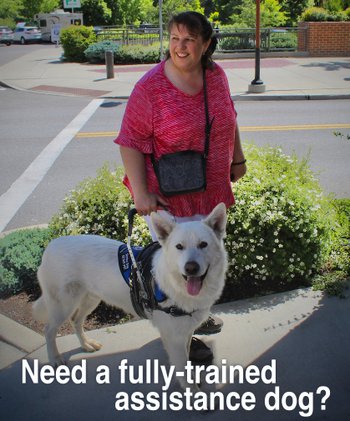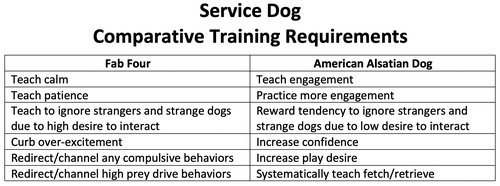Do American Dirus Dogs Make Good Service Dogs?
By Jennifer Stoeckl, MAT - Dire Wolf Project CEO, Aug. 11, 2021
Recently, we have had a strong increase in people seeking an American Alsatian dog for service work... mainly PTSD/anxiety related. At least 25-30% of new applications are in this category. A big increase over the last two years.
Today, I want to address the use of an American Alsatian dog as a service dog and why one should do their research before choosing the American Alsatian dog as the breed you want for your service dog.
First of all, it is important to note that American Alsatian dog breeders breed for a specific and unique companion dog temperament. We do not breed specifically for service dog temperament and never will. This breed is set up to be the best companion dog we can possibly make them, where training is easiest for a family with little knowledge of dog training. We strive to eliminate as many working dog traits as we can. Service dog work, especially guide dog work, some specific mobility tasks (like consistently retrieving dropped items), and any other higher energy/focused tasks do not come naturally to our breed, whereas those aspects do come naturally in other breeds. That is the reason why DireWolf Guardians does not train guide dogs and only chooses recipients based on tasking needs that match with the abilities of this breed.
It is true that not every American Alsatian dog will make a good service dog.
It is also true that the American Alsatian dogs that do go on to become excellent service dogs do NOT fit the normal profile of an ideal temperament chosen for service dog work. If someone were to temperament test our dogs with the normal test used to determine good reactions to different stimuli, our dogs would fail miserably. That is because American Alsatian dogs are not super outgoing and confident. American Alsatian dogs do not interact easily with balls and toys. Our dogs can be cautious of new environments and are highly alert to even small changes, which challenges their emotional state and focus.
Training a good service dog candidate from the Fab Four (Golden Retriever, Labrador Retriever, Standard Poodle, Collie) is usually recommended by service dog training facilities because training that specific combination of temperament traits has been standardized to a fairly high degree. You are not always guaranteed to acquire a dog from these four breeds that will have what you need, but when you do, training them in the procedural way has already been well established with lots of resources to guide you.
That is why I post as much information regarding training for our breed as I do. I hope to help everyone see the important differences in training an American Alsatian dog for service work as opposed to the breeds that are normally chosen for service tasks.
To state this again as clearly as possible: American Alsatian dogs cannot be trained for service dog work in the same way as the Fab Four.
If someone wants to train our dogs for service work, that person needs to understand this. American Alsatian dogs are soft-hearted and reliant on their people for support and connection. This is not a desired trait in the service dog community. We have found that it is an ideal trait for someone with PTSD/anxiety because they bond so strongly to their human. The close connection that comes with an American Alsatian dog is a great asset for someone in need of emotional support and attentiveness. But, it also means that training must be altered to accommodate such a trait.
Again for emphasis: Training must be altered to fit the different needs of a sensitive American Alsatian dog.
Instead of working hard to calm an outgoing, higher-energy Fab Four candidate, we must draw out the more introverted American Alsatian dog in our training. Our dogs are calm enough already to easily attend to their humans without being taught.
You see, it is almost an opposite approach to training. Check out the list below for a more graphic representation to illustrate this concept:

I will continue to share as much as I can with everyone about the difference in training our dogs so that people will be knowledgeable enough to be as successful as possible with their American Alsatian dogs, but going by the standards for the traditionally chosen traits of a service dog, this breed does not typically fit the mold.
To be sure, certain special American Alsatian dogs have a great potential to be excellent service dogs, especially for PTSD/anxiety type work, however, training one for service work is NOT the same as training a typically chosen service dog temperament. It is ESSENTIAL to understand this when speaking with others about this breed for service work.
The reason I began DireWolf Guardians initially was to help teach others the fundamentally different training techniques needed when using this breed for various service dog activities. I wanted to highlight the value of our breed to this important aspect of dog use. But, our dogs are not recommended for certain service dog tasks, such as guide dog work, because of their lack of drive and lack of energetic/enthusiastic response.
It is possible to have an amazing service dog from this breed, but the work to get there is not typical. Many outsiders do not understand this or even acknowledge the very real possibility of a different way of training a service dog. We have seen this bias toward using only dogs with outgoing/confident personalities first hand from trainers. It is okay for them to have this bias. Many of them have successfully trained loads of super hero dogs and the typical temperament they choose works perfectly well for their needs.
American Alsatian dogs are pretty great, but they aren't great at everything. They are especially fabulous at being bonded, loving, attentive, and snuggly, so we can use those super strengths to our advantage when we find the right temperament that also fits with service dog work.
Jennifer Stoeckl is the co-founder of the Dire Wolf Project, founder of the DireWolf Guardians American Alsatian Dog Training Program, and owner/operator of DireWolf Dogs of Vallecito. She lives in the beautiful inland northwest among the Ponderosa pine forests with her pack of American Alsatian dogs.